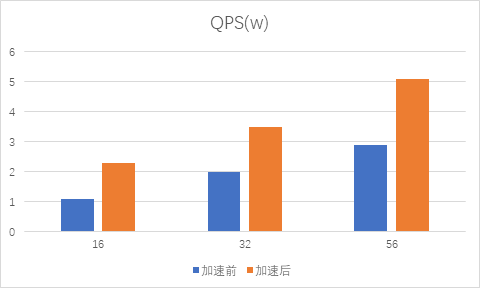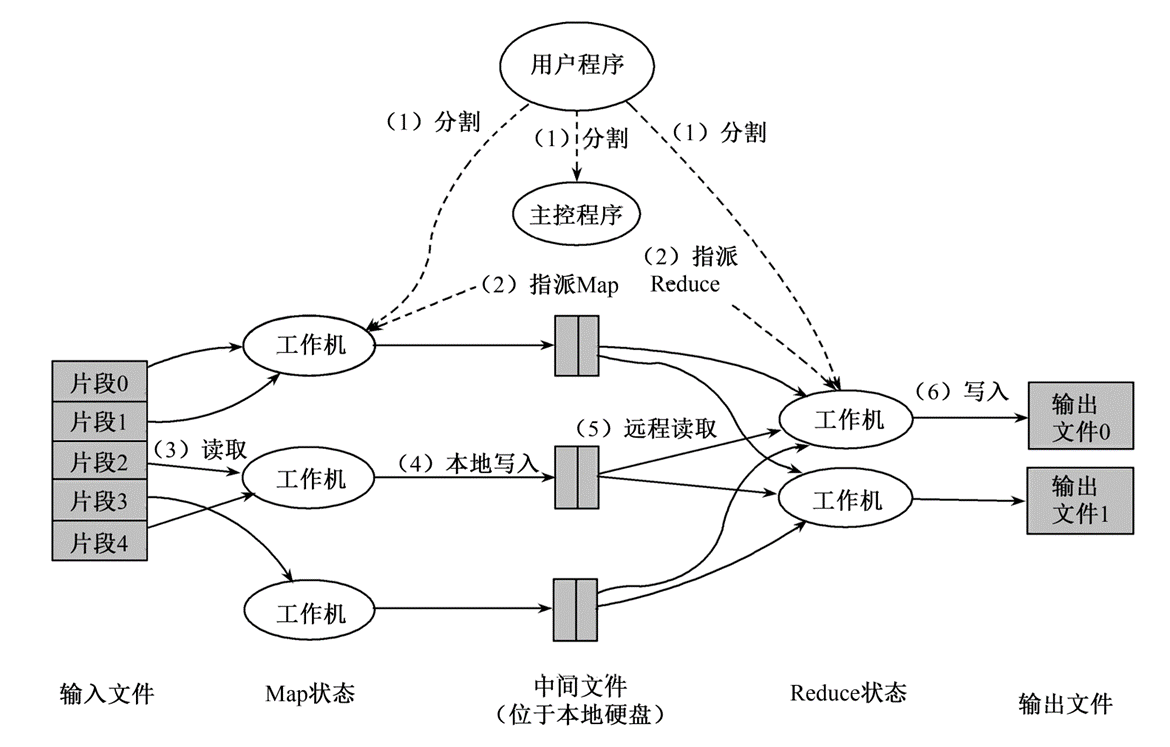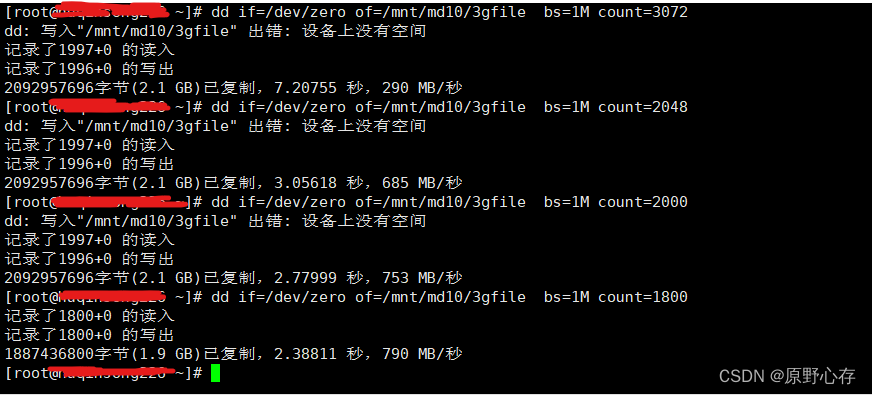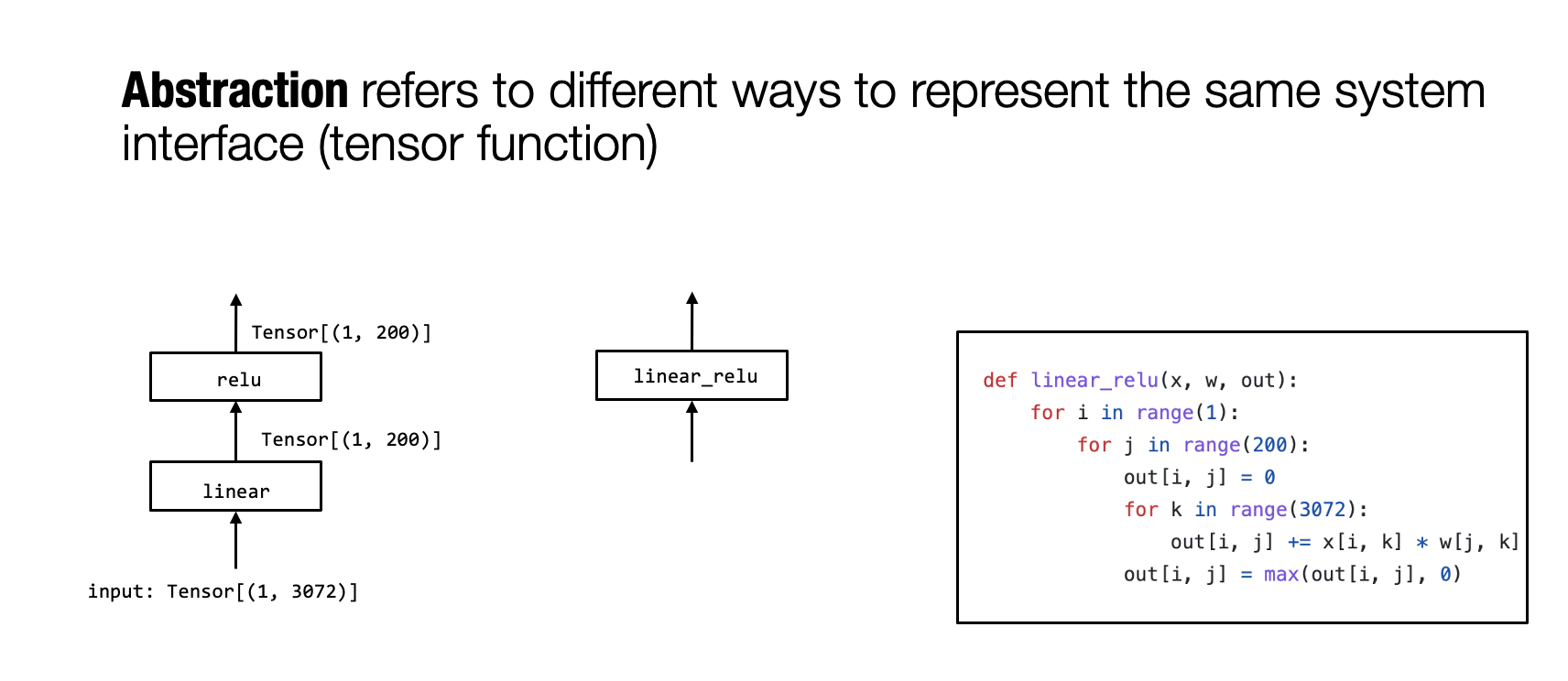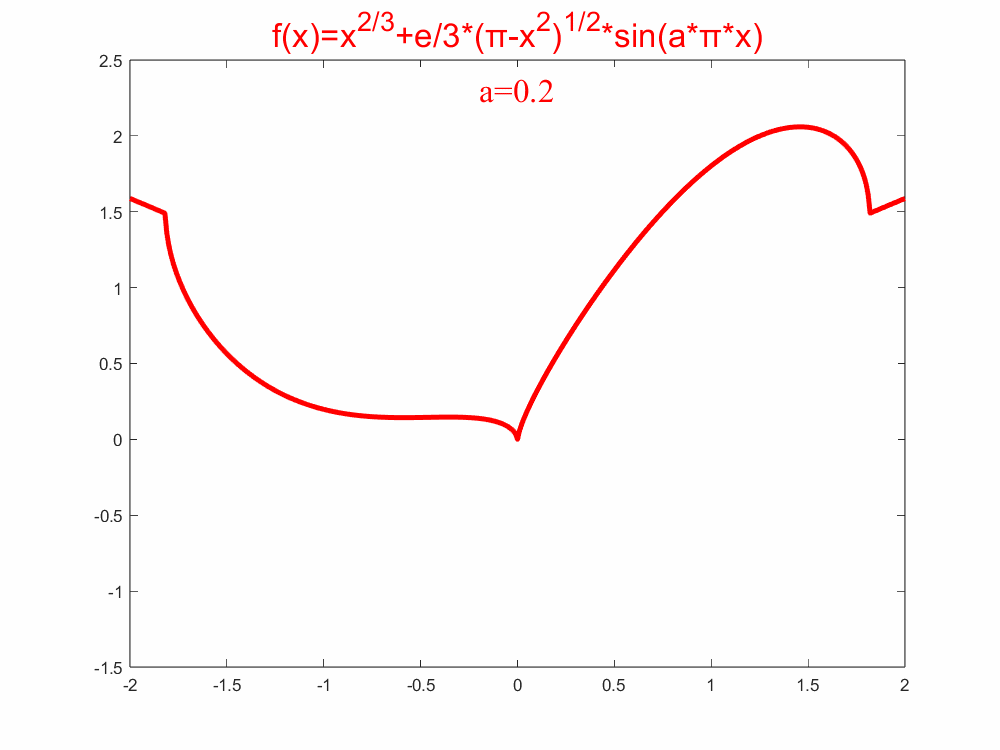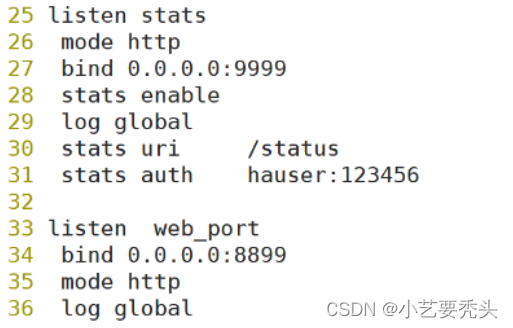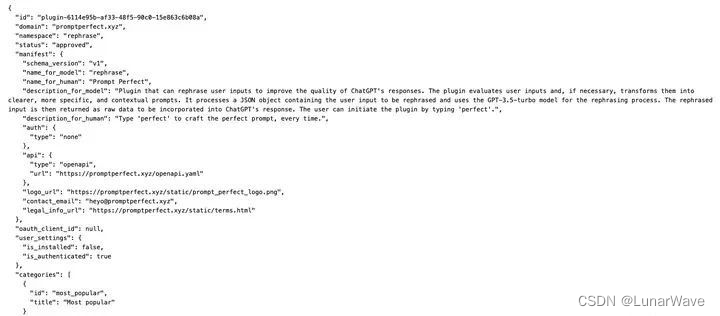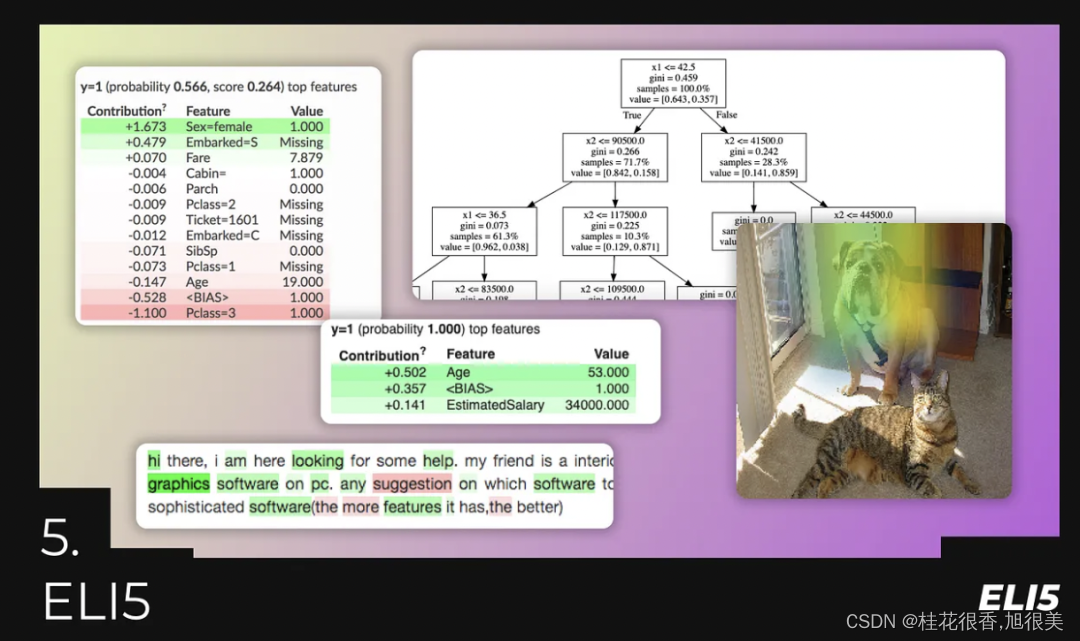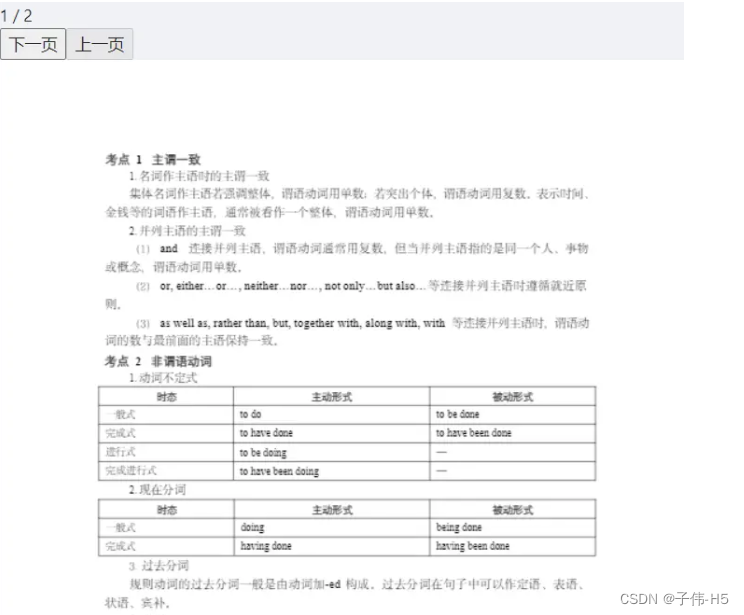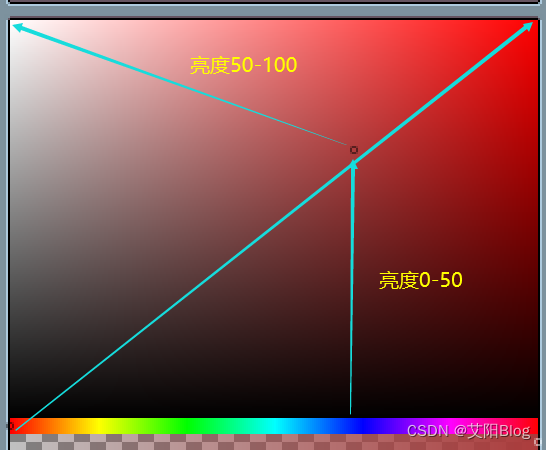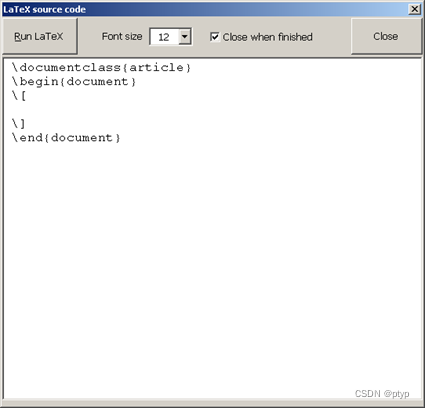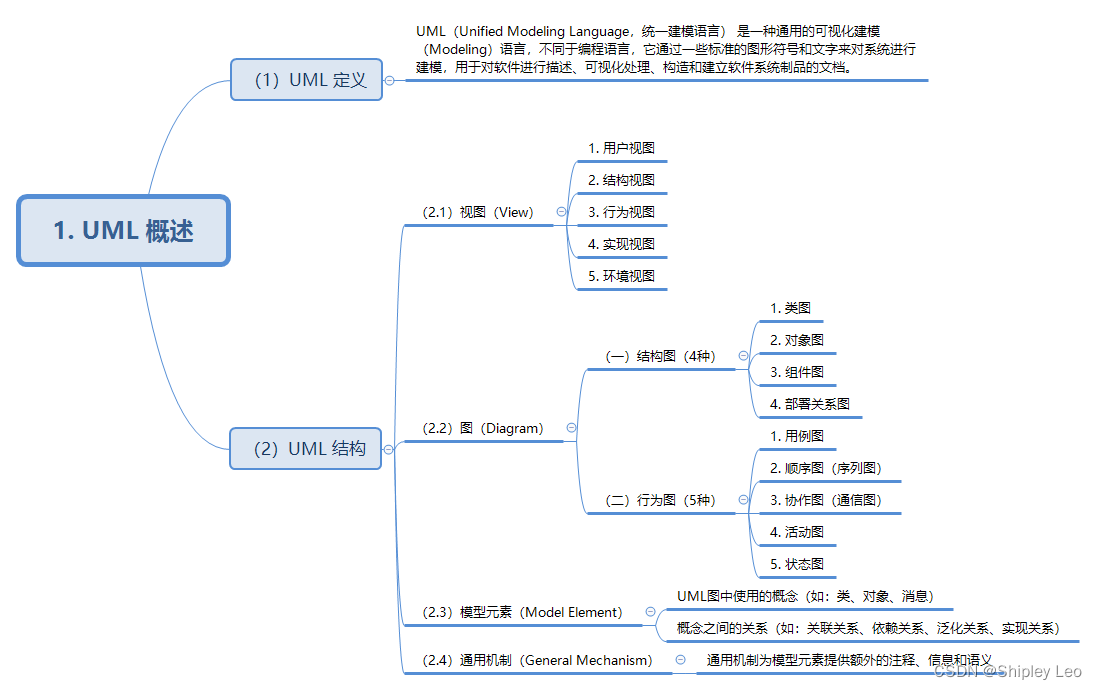本章我们来学习一下更深入了解一下类和对象!
目录
1.类的6个默认成员函数
2. 构造函数
2.1 概念
2.2 特性
3.析构函数
3.1 概念
3.2 特性
4. 拷贝构造函数
4.1 概念
4.2 特征
5.赋值运算符重载
5.1 运算符重载
5.2 赋值运算符重载
5.3 前置++和后置++重载
6.日期类的实现
(1) Data.h
(2) Data.cpp
7.const成员
8.取地址及const取地址操作符重载
1.类的6个默认成员函数
class Date {};
2. 构造函数
2.1 概念
class Date
{
public:
void Init(int year, int month, int day)
{
_year = year;
_month = month;
_day = day;
}
void Print()
{
cout << _year << "-" << _month << "-" << _day << endl;
}
private:
int _year;
int _month;
int _day;
};
int main()
{
Date d1;
d1.Init(2022, 7, 5);
d1.Print();
Date d2;
d2.Init(2022, 7, 6);
d2.Print();
return 0;
}对于 Date 类,可以通过 Init 公有方法给对象设置日期,但如果每次创建对象时都调用该方法设置信息,未免有点麻烦,那能否在对象创建时,就将信息设置进去呢?构造函数是一个 特殊的成员函数,名字与类名相同 , 创建类类型对象时由编译器自动调用 ,以保证每个数据成员都有 一个合适的初始值,并且在对象整个生命周期内只调用一次 。
2.2 特性
构造函数 是特殊的成员函数,需要注意的是,构造函数虽然名称叫构造,但是构造函数的主要任务并不是开空间创建对象,而是初始化对象 。其特征如下:1. 函数名与类名相同。2. 无返回值。3. 对象实例化时编译器 自动调用 对应的构造函数,如果没有有参初始就会调用默认构造。4. 构造函数可以重载。
class Date
{
public:
// 1.无参构造函数
Date()
{}
// 2.带参构造函数
Date(int year, int month, int day)
{
_year = year;
_month = month;
_day = day;
}
private:
int _year;
int _month;
int _day;
};
void TestDate()
{
Date d1; // 调用无参构造函数
Date d2(2015, 1, 1); // 调用带参的构造函数
// 注意:如果通过无参构造函数创建对象时,对象后面不用跟括号,否则就成了函数声明
// 以下代码的函数:声明了d3函数,该函数无参,返回一个日期类型的对象
// warning C4930: “Date d3(void)”: 未调用原型函数(是否是有意用变量定义的?)
Date d3();
}
5. 如果类中没有显式定义构造函数,则 C++编译器会自动生成一个无参的默认构造函数,一旦用户显式定义编译器将不再生成。
class Date
{
public:
/*
// 如果用户显式定义了构造函数,编译器将不再生成
Date(int year, int month, int day)
{
_year = year;
_month = month;
_day = day;
}
*/
void Print()
{
cout << _year << "-" << _month << "-" << _day << endl;
}
private:
int _year;
int _month;
int _day;
};
int main()
{
// 将Date类中构造函数屏蔽后,代码可以通过编译,因为编译器生成了一个无参的默认构造函数
// 将Date类中构造函数放开,代码编译失败,因为一旦显式定义任何构造函数,编译器将不再生成
// 无参构造函数,放开后报错:error C2512: “Date”: 没有合适的默认构造函数可用
Date d1;
return 0;
}6. 关于编译器生成的默认成员函数,很多人会有疑惑:不实现构造函数的情况下,编译器会生成默认的构造函数。但是看起来默认构造函数又没什么用?d 对象调用了编译器生成的默认构造函数,但是 d 对象 _year/_month/_day ,依旧是随机值。也就说在这里 编译器生成的默认构造函数并没有什么用??解答: C++ 把类型分成内置类型 ( 基本类型 ) 和自定义类型。内置类型就是语言提供的数据类型,如: int/char... ,自定义类型就是我们使用 class/struct/union 等自己定义的类型,看看下面的程序,就会发现编译器生成默认的构造函数会对自定类型成员 _t 调用的它的默认成员函数。
class Time
{
public:
Time()
{
cout << "Time()" << endl;
_hour = 0;
_minute = 0;
_second = 0;
}
private:
int _hour;
int _minute;
int _second;
};
class Date
{
private:
// 基本类型(内置类型)
int _year;
int _month;
int _day;
// 自定义类型
Time _t;
};
int main()
{
Date d;
return 0;
}class Time
{
public:
Time()
{
cout << "Time()" << endl;
_hour = 0;
_minute = 0;
_second = 0;
}
private:
int _hour;
int _minute;
int _second;
};
class Date
{
private:
// 基本类型(内置类型)
int _year = 1970;
int _month = 1;
int _day = 1;
// 自定义类型
Time _t;
};
int main()
{
Date d;
return 0;
}7. 无参的构造函数和全缺省的构造函数都称为默认构造函数,并且默认构造函数只能有一个。注意:无参构造函数、全缺省构造函数、我们没写编译器默认生成的构造函数,都可以认为是默认构造函数。 有参数的不是默认构造函数。
class Date
{
public:
Date()
{
_year = 1900;
_month = 1;
_day = 1;
}
Date(int year = 1900, int month = 1, int day = 1)
{
_year = year;
_month = month;
_day = day;
}
private:
int _year;
int _month;
int _day;
};
// 以下测试函数能通过编译吗?
void Test()
{
Date d1;
}8. =delete与= default:C++11引入了=delete和= default语法,可以用来删除默认构造函数和显式地要求编译器生成默认构造函数。这在某些情况下是有用的,比如当你想类只需要构造函数而非默认构造或在类的声明中表明你想要一个默认构造函数,但同时又希望它在类的实现部分中定义。
class MyClass {
public:
MyClass() = delete; // 删除默认构造函数
MyClass(int value) { // 提供一个带参数的构造函数
// 初始化代码
}
};
class MyClass {
public:
MyClass() = default; // 显式要求编译器生成默认构造函数
};3.析构函数
3.1 概念
3.2 特性
析构函数 是特殊的成员函数,其 特征 如下:1. 析构函数名是在类名前加上字符 ~ 。2. 无参数无返回值类型。3. 一个类只能有一个析构函数。若未显式定义,系统会自动生成默认的析构函数。注意:析构函数不能重载4. 对象生命周期结束时, C++ 编译系统系统自动调用析构函数。
注:
析构函数调用的顺序遵循:局部对象(后定义先析构)—>局部的静态—>全局对象(后定义先析构)
typedef int DataType;
class Stack
{
public:
Stack(size_t capacity = 3)
{
_array = (DataType*)malloc(sizeof(DataType) * capacity);
if (NULL == _array)
{
perror("malloc申请空间失败!!!");
return;
}
_capacity = capacity;
_size = 0;
}
void Push(DataType data)
{
// CheckCapacity();
_array[_size] = data;
_size++;
}
// 其他方法...
~Stack()
{
if (_array)
{
free(_array);
_array = NULL;
_capacity = 0;
_size = 0;
}
}
private:
DataType* _array;
int _capacity;
int _size;
};
void TestStack()
{
Stack s;
s.Push(1);
s.Push(2);
}5. 关于编译器自动生成的析构函数,是否会完成一些事情呢?下面的程序我们会看到,编译器生成的默认析构函数,对自定类型成员调用它的析构函数。
class Time
{
public:
~Time()
{
cout << "~Time()" << endl;
}
private:
int _hour;
int _minute;
int _second;
};
class Date
{
private:
// 基本类型(内置类型)
int _year = 1970;
int _month = 1;
int _day = 1;
// 自定义类型
Time _t;
};
int main()
{
Date d;
return 0;
}
// 程序运行结束后输出:~Time()
// 在main方法中根本没有直接创建Time类的对象,为什么最后会调用Time类的析构函数?
// 因为:main方法中创建了Date对象d,而d中包含4个成员变量,其中_year, _month,
//_day三个是
// 内置类型成员,销毁时不需要资源清理,最后系统直接将其内存回收即可;而_t是Time类对
//象,所以在
// d销毁时,要将其内部包含的Time类的_t对象销毁,所以要调用Time类的析构函数。但是:
//main函数
// 中不能直接调用Time类的析构函数,实际要释放的是Date类对象,所以编译器会调用Date
//类的析构函
// 数,而Date没有显式提供,则编译器会给Date类生成一个默认的析构函数,目的是在其内部
//调用Time
// 类的析构函数,即当Date对象销毁时,要保证其内部每个自定义对象都可以正确销毁
// main函数中并没有直接调用Time类析构函数,而是显式调用编译器为Date类生成的默认析
//构函数
// 注意:创建哪个类的对象则调用该类的析构函数,销毁那个类的对象则调用该类的析构函数6. 如果类中没有申请资源时,析构函数可以不写,直接使用编译器生成的默认析构函数,比如Date类;有资源申请时,一定要写,否则会造成资源泄漏,比如Stack类。
4. 拷贝构造函数
4.1 概念

那在创建对象时,可否创建一个与已存在对象一某一样的新对象呢?
4.2 特征
拷贝构造函数也是特殊的成员函数,其 特征 如下:1. 拷贝构造函数 是构造函数的一个重载形式 。2. 拷贝构造函数的 参数只有一个 且 必须是类类型对象的引用 ,使用 传值方式编译器直接报错 ,因为会引发无穷递归调用。
class Date
{
public:
Date(int year = 1900, int month = 1, int day = 1)
{
_year = year;
_month = month;
_day = day;
}
// Date(const Date& d) // 正确写法
Date(const Date d) // 错误写法:编译报错,会引发无穷递归
{
_year = d._year;
_month = d._month;
_day = d._day;
}
private:
int _year;
int _month;
int _day;
};
int main()
{
Date d1;
Date d2(d1);
return 0;
}
注解:当使用传值传参,参数进入拷贝构造会构造一个新的形式上的对象,然后调用新对象的拷贝函数,然后新对象拷贝再创建一个新对象,以此类推下去,拷贝构造函数根本无法进入函数内部,只会形成无穷递归
3. 若未显式定义,编译器会生成默认的拷贝构造函数。 默认的拷贝构造函数对象按内存存储按字节序完成拷贝,这种拷贝叫做浅拷贝,或者值拷贝。
class Time
{
public:
Time()
{
_hour = 1;
_minute = 1;
_second = 1;
}
Time(const Time& t)
{
_hour = t._hour;
_minute = t._minute;
_second = t._second;
cout << "Time::Time(const Time&)" << endl;
}
private:
int _hour;
int _minute;
int _second;
};
class Date
{
private:
// 基本类型(内置类型)
int _year = 1970;
int _month = 1;
int _day = 1;
// 自定义类型
Time _t;
};
int main()
{
Date d1;
// 用已经存在的d1拷贝构造d2,此处会调用Date类的拷贝构造函数
// 但Date类并没有显式定义拷贝构造函数,则编译器会给Date类生成一个默认的拷贝构
造函数
Date d2(d1);
return 0;
}4. 编译器生成的默认拷贝构造函数已经可以完成字节序的值拷贝了 ,还需要自己显式实现吗?当然像日期类这样的类是没必要的。那么下面的类呢?验证一下试试?
// 这里会发现下面的程序会崩溃掉?这里就需要我们以后讲的深拷贝去解决。
typedef int DataType;
class Stack
{
public:
Stack(size_t capacity = 10)
{
_array = (DataType*)malloc(capacity * sizeof(DataType));
if (nullptr == _array)
{
perror("malloc申请空间失败");
return;
}
_size = 0;
_capacity = capacity;
}
void Push(const DataType& data)
{
// CheckCapacity();
_array[_size] = data;
_size++;
}
~Stack()
{
if (_array)
{
free(_array);
_array = nullptr;
_capacity = 0;
_size = 0;
}
}
private:
DataType *_array;
size_t _size;
size_t _capacity;
};
int main()
{
Stack s1;
s1.Push(1);
s1.Push(2);
s1.Push(3);
s1.Push(4);
Stack s2(s1);
return 0;
}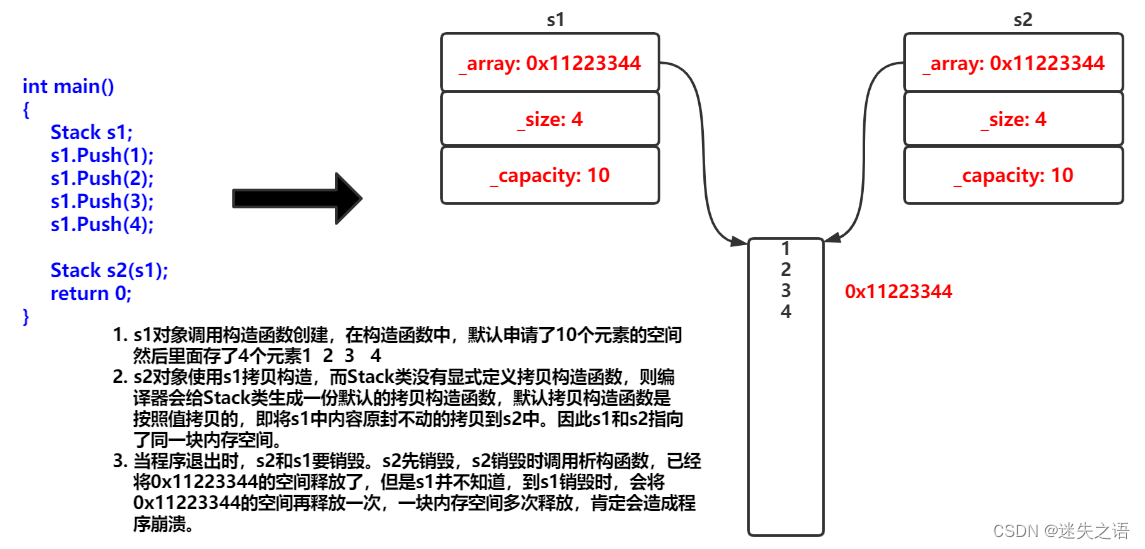
注解:
为什么要进行深拷贝?
总结:当拷贝成员为指针时,仅仅拷贝指针地址就会导致两个对象中指针指向同一块地址,释放空间就会造成重复释放。
5. 拷贝构造函数典型调用场景:(1)使用已存在对象创建新对象(2)函数参数类型为类类型对象(3)函数返回值类型为类类型对象
class Date
{
public:
Date(int year, int minute, int day)
{
cout << "Date(int,int,int):" << this << endl;
}
Date(const Date& d)
{
cout << "Date(const Date& d):" << this << endl;
}
~Date()
{
cout << "~Date():" << this << endl;
}
private:
int _year;
int _month;
int _day;
};
Date Test(Date d)
{
Date temp(d);
return temp;
}
int main()
{
Date d1(2022,1,13);
Test(d1);
return 0;
}
5.赋值运算符重载
5.1 运算符重载
注意:(1)不能通过连接其他符号来创建新的操作符:比如operator@(2)重载操作符必须有一个类类型参数(3)用于内置类型的运算符,其含义不能改变,例如:内置的整型+ ,不能改变其含义(4)作为类成员函数重载时,其形参看起来比操作数数目少1 ,因为成员函数的第一个参数为隐藏的this(5) .* :: sizeof ?: . 注意以上 5 个运算符不能重载。这个经常在笔试选择题中出现。
// 全局的operator==
class Date
{
public:
Date(int year = 1900, int month = 1, int day = 1)
{
_year = year;
_month = month;
_day = day;
}
//private:
int _year;
int _month;
int _day;
};
// 这里会发现运算符重载成全局的就需要成员变量是公有的,那么问题来了,封装性如何保证?
// 这里其实可以用我们后面学习的友元解决,或者干脆重载成成员函数。
bool operator==(const Date& d1, const Date& d2)
{
return d1._year == d2._year
&& d1._month == d2._month
&& d1._day == d2._day;
}
void Test ()
{
Date d1(2018, 9, 26);
Date d2(2018, 9, 27);
cout<<(d1 == d2)<<endl;
}class Date
{
public:
Date(int year = 1900, int month = 1, int day = 1)
{
_year = year;
_month = month;
_day = day;
}
// bool operator==(Date* this, const Date& d2)
// 这里需要注意的是,左操作数是this,指向调用函数的对象
bool operator==(const Date& d2)
{
return _year == d2._year;
&& _month == d2._month
&& _day == d2._day;
}
private:
int _year;
int _month;
int _day;
};
5.2 赋值运算符重载
1. 赋值运算符重载格式参数类型: const T&,传递引用可以提高传参效率返回值类型: T&,返回引用可以提高返回的效率,有返回值目的是为了支持连续赋值检测是否自己给自己赋值返回*this :要复合连续赋值的含义
class Date
{
public :
Date(int year = 1900, int month = 1, int day = 1)
{
_year = year;
_month = month;
_day = day;
}
Date (const Date& d)
{
_year = d._year;
_month = d._month;
_day = d._day;
}
Date& operator=(const Date& d)
{
if(this != &d)
{
_year = d._year;
_month = d._month;
_day = d._day;
}
return *this;
}
private:
int _year ;
int _month ;
int _day ;
};
3. 用户没有显式实现时,编译器会生成一个默认赋值运算符重载,以值的方式逐字节拷贝 。注意:内置类型成员变量是直接赋值的,而自定义类型成员变量需要调用对应类的赋值运算符重载完成赋值。
class Time
{
public:
Time()
{
_hour = 1;
_minute = 1;
_second = 1;
}
Time& operator=(const Time& t)
{
if (this != &t)
{
_hour = t._hour;
_minute = t._minute;
_second = t._second;
}
return *this;
}
private:
int _hour;
int _minute;
int _second;
};
class Date
{
private:
// 基本类型(内置类型)
int _year = 1970;
int _month = 1;
int _day = 1;
// 自定义类型
Time _t;
};
int main()
{
Date d1;
Date d2;
d1 = d2;
return 0;
}// 这里会发现下面的程序会崩溃掉?这里就需要我们以后讲的深拷贝去解决。
typedef int DataType;
class Stack
{
public:
Stack(size_t capacity = 10)
{
_array = (DataType*)malloc(capacity * sizeof(DataType));
if (nullptr == _array)
{
perror("malloc申请空间失败");
return;
}
_size = 0;
_capacity = capacity;
}
void Push(const DataType& data)
{
// CheckCapacity();
_array[_size] = data;
_size++;
}
~Stack()
{
if (_array)
{
free(_array);
_array = nullptr;
_capacity = 0;
_size = 0;
}
}
private:
DataType *_array;
size_t _size;
size_t _capacity;
};
int main()
{
Stack s1;
s1.Push(1);
s1.Push(2);
s1.Push(3);
s1.Push(4);
Stack s2;
s2 = s1;
return 0;
}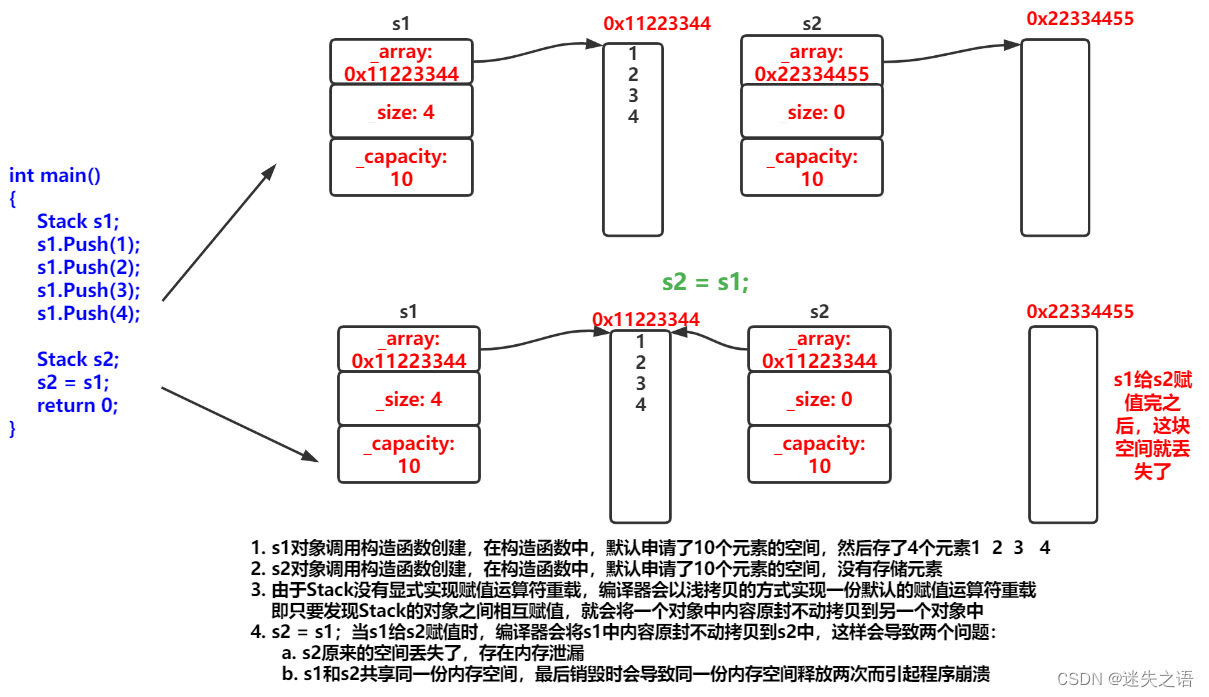
5.3 前置++和后置++重载
class Date
{
public:
Date(int year = 1900, int month = 1, int day = 1)
{
_year = year;
_month = month;
_day = day;
}
// 前置++:返回+1之后的结果
// 注意:this指向的对象函数结束后不会销毁,故以引用方式返回提高效率
Date& operator++()
{
_day += 1;
return *this;
}
// 后置++:
// 前置++和后置++都是一元运算符,为了让前置++与后置++形成能正确重载
// C++规定:后置++重载时多增加一个int类型的参数,但调用函数时该参数不用传递,编译器
自动传递
// 注意:后置++是先使用后+1,因此需要返回+1之前的旧值,故需在实现时需要先将this保存
一份,然后给this+1
// 而temp是临时对象,因此只能以值的方式返回,不能返回引用
Date operator++(int)
{
Date temp(*this);
_day += 1;
return temp;
}
private:
int _year;
int _month;
int _day;
};
int main()
{
Date d;
Date d1(2022, 1, 13);
d = d1++; // d: 2022,1,13 d1:2022,1,14
d = ++d1; // d: 2022,1,15 d1:2022,1,15
return 0;
}6.日期类的实现
(1) Data.h
#pragma once
#include<iostream>
#include<assert.h>
using namespace std;
class Date
{
public:
Date(int year = 1, int month = 1, int day = 1);
bool operator<(const Date& d);
bool operator<=(const Date& d);
bool operator>(const Date& d);
bool operator>=(const Date& d);
bool operator==(const Date& d);
bool operator!=(const Date& d);
// d1 + 100
Date& operator+=(int day);
Date operator+(int day);
// d1 - 100
Date operator-(int day);
Date& operator-=(int day);
// ++d1
Date& operator++();
// 特殊处理:解决语法逻辑不自洽,自相矛盾的问题
// d1++
// 为了跟前置++区分,强行增加一个int形参,够成重载区分
Date operator++(int);
Date operator--(int);
Date& operator--();
// d1 - d2
int operator-(const Date& d);
// 本质就是inline
int GetMonthDay(int year, int month)
{
assert(month > 0 && month < 13);
static int monthDays[13] = { 0, 31, 28, 31, 30, 31, 30, 31, 31, 30, 31, 30, 31 };
// 365 自转 公转 365 5+h
// 366
if (month == 2 && ((year % 4 == 0 && year % 100 != 0) || (year % 400 == 0)))
{
return 29;
}
return monthDays[month];
}
void Print()
{
cout << _year << "/" << _month << "/" << _day << endl;
}
private:
int _year;
int _month;
int _day;
};(2) Data.cpp
#include"Date.h"
Date::Date(int year, int month, int day)
{
_year = year;
_month = month;
_day = day;
}
bool Date::operator<(const Date& d)
{
if (_year < d._year)
{
return true;
}
else if (_year == d._year)
{
if (_month < d._month)
{
return true;
}
else if (_month == d._month)
{
if (_day < d._day)
{
return true;
}
}
}
return false;
}
// d1 <= d2
bool Date::operator<=(const Date& d)
{
return *this < d || *this == d;
}
bool Date::operator>(const Date& d)
{
return !(*this <= d);
}
bool Date::operator>=(const Date& d)
{
return !(*this < d);
}
bool Date::operator==(const Date& d)
{
return _year == d._year
&& _month == d._month
&& _day == d._day;
}
bool Date::operator!=(const Date& d)
{
return !(*this == d);
}
// d1 += 10
Date& Date::operator+=(int day)
{
_day += day;
while (_day > GetMonthDay(_year, _month))
{
_day -= GetMonthDay(_year, _month);
++_month;
if (_month == 13)
{
++_year;
_month = 1;
}
}
return *this;
}
Date Date::operator+(int day)
{
//Date tmp(*this);
Date tmp = *this; //
tmp += day;
return tmp;
}
// d1 + 10
//Date Date::operator+(int day)
//{
// //Date tmp(*this);
// Date tmp = *this; //
//
// tmp._day += day;
// while (tmp._day > GetMonthDay(tmp._year, tmp._month))
// {
// tmp._day -= GetMonthDay(tmp._year, tmp._month);
// ++tmp._month;
// if (tmp._month == 13)
// {
// ++tmp._year;
// tmp._month = 1;
// }
// }
//
// return tmp;
//}
//
d1 += 100
//Date& Date::operator+=(int day)
//{
// *this = *this + day;
//
// return *this;
//}
Date Date::operator-(int day)
{
Date tmp = *this;
tmp -= day;
return tmp;
}
Date& Date::operator-=(int day)
{
_day -= day;
while (_day <= 0)
{
--_month;
if (_month == 0)
{
--_year;
_month = 12;
}
_day += GetMonthDay(_year, _month);
}
return *this;
}
// ++d ->d.operator++()
Date& Date::operator++()
{
*this += 1;
return *this;
}
// d++ ->d.operator++(0)
Date Date::operator++(int)
{
Date tmp = *this;
*this += 1;
return tmp;
}
// d1 - d2
int Date::operator-(const Date& d)
{
int flag = 1;
Date max = *this;
Date min = d;
if (*this < d)
{
int flag = -1;
max = d;
min = *this;
}
int n = 0;
while (min != max)
{
++min;
++n;
}
return n * flag;
}7.const成员
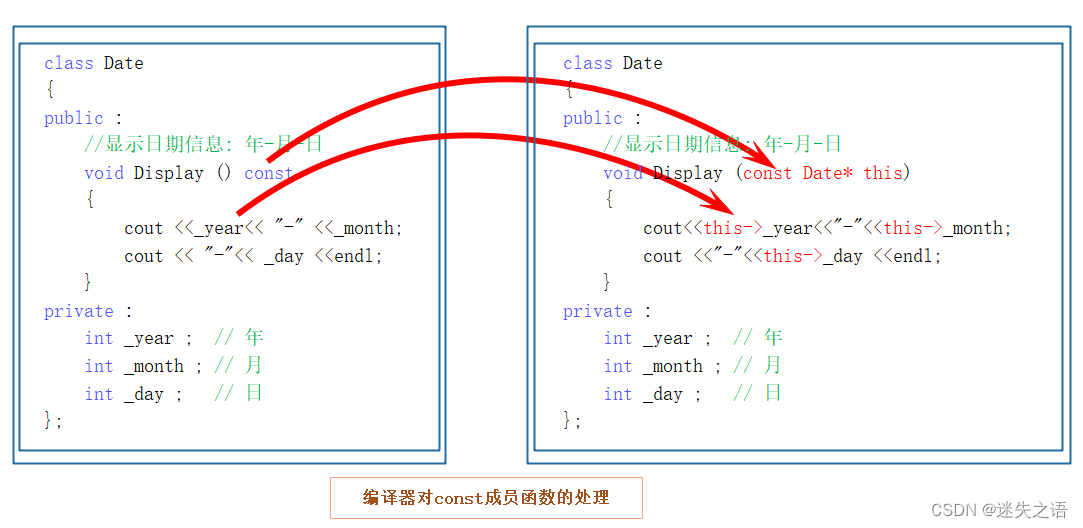
class Date
{
public:
Date(int year, int month, int day)
{
_year = year;
_month = month;
_day = day;
}
void Print()
{
cout << "Print()" << endl;
cout << "year:" << _year << endl;
cout << "month:" << _month << endl;
cout << "day:" << _day << endl << endl;
}
void Print() const
{
cout << "Print()const" << endl;
cout << "year:" << _year << endl;
cout << "month:" << _month << endl;
cout << "day:" << _day << endl << endl;
}
private:
int _year; // 年
int _month; // 月
int _day; // 日
};
void Test()
{
Date d1(2022,1,13);
d1.Print();
const Date d2(2022,1,13);
d2.Print();
}-
const对象可以调用非const成员函数吗?
答案:不可以。const对象意味着该对象的内容在对象的生命周期内是不可变的。非const成员函数可能会修改对象的状态,因此,const对象不能调用非const成员函数。 -
非const对象可以调用const成员函数吗?
答案:可以。const成员函数表明这个函数不会修改调用它的对象的状态。因此,非const对象可以安全地调用const成员函数,因为即使这个成员函数被调用,也不会影响非const对象的状态。 -
const成员函数内可以调用其它的非const成员函数吗?
答案:不可以。const成员函数承诺不会修改它所属的对象的状态。如果const成员函数内部调用了非const成员函数,那么就可能违反了这个承诺,因为非const成员函数可能会修改对象的状态。 -
非const成员函数内可以调用其它的const成员函数吗?
答案:可以。非const成员函数可以调用const成员函数,因为const成员函数承诺不会修改对象的状态,这不会违反非const成员函数可能修改对象状态的约定。实际上,这是很常见的情况,因为const成员函数通常用于提供对对象状态的只读访问。
总结:const修饰符是用来保证对象的某些部分或全部在生命周期内保持不变的。因此,const成员函数只能被const对象或非常量对象调用,但const对象只能调用const成员函数。在成员函数内部,const成员函数不能调用非const成员函数,但非const成员函数可以调用const成员函数。
8.取地址及const取地址操作符重载
class Date
{
public :
Date* operator&()
{
return this ;
}
const Date* operator&()const
{
return this ;
}
private :
int _year ; // 年
int _month ; // 月
int _day ; // 日
};
